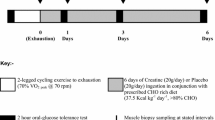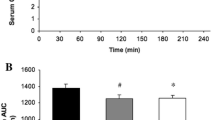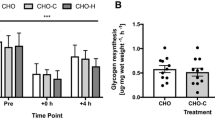Abstract
The main aim of this study was to examine the hypothesis that creatine (Cr) feeding enhances myocellular glycogen storage in humans undergoing carbohydrate loading. Twenty trained male subjects were randomly assigned to have their diets supplemented daily with 252 g of glucose polymer (GP) and either 21 g of Cr (CRGP, n=10) or placebo (PL-GP, n=10) for 5 days. Changes in resting myocellular glycogen and phosphocreatine (PCr) were determined with Magnetic Resonance Spectroscopy (13C- and31P-MRS, respectively). After CR-GP, the levels of intramyocellular glycogen increased from 147±13 (standard error) mmol·(kg wet weight)−1) to 182±17 mmol·(kg wet weight)−1, while it increased from 134±17 mmol·(kg wet weight)− to 182±17 mmol·(kg wet weight)−1 after PL-GP; the increments in intramyocellular glycogen concentrations were not statistically different. The increment in the PCr/ATP ratio after CR-GP (+0.20±0.12) was significantly different compared to PL-GP (−0.34±0.16) (p<0.05). The present results do not support the hypothesis that Cr loading increases muscle glycogen storage.
Resumen
El principal objetivo de este estudio fue examinar la hipótesis que la suplementación con creatina (Cr) aumenta la concentración de glucógeno intramiocelular en humanos durante un periodo de ingesta elevada de hídratos de carbono. Veinte hombres entrenados fueron asignados de manera randomizada a dietas suplementadas diariamente con 252 g de polímeros de glucosa (GP) y bien 21 g de Cr (CR-GP, n=10) o placebo (PL-GP, n=10) durante 5 días. Los cambios en los níveles de glucógeno intramiocelular, y fosfocreatina (PCr) y ATP fueron determinados en reposo con Espectroscopía de Resonancia Magnética (13C-and31PMRS, respectivamente). Despues de CR-GP, Los níveles de glucógeno incrementaron desde 147±13 (error standard) mmol·(kg peso húmedo−1) a 172±13 mmol·(kg peso húmedo1), mientras incrementó desde 134±17 mmol·(kg peso húmedo−1) a 182±17 mmol·(kg peso húmedo−1) despues de PL-GP; los incrementos en la concentración de glucógeno intramiocelular en CR-GP y PL-GP no fueron estadisticamente diferentes. El incremento en el cociente PCr/ATP después de CR-GP (+0.20±0.12) fue estadisticamente diferente comparado con el cambio después de PL-GP (−0.34±0.16) (p<0.05). Los resultados no apoyan la hipótesis de que la creatina incrementa la concentración de glucógeno intramiocelular.
Similar content being viewed by others
References
Balsom, P.D, Soderlund, K., Sjodin, B. and Ekblom, B. (1995): Skeletal muscle metabolism during short duration high-intensity exercise: influence of creatine supplementation. Acta Physiol Scand, 154, 303–310.
Bergstrom J, G. Guarnieri, E. Hultman. (1971): Carbohydrate metabolism and electrolyte changes in human muscle tissue during heavy work. J Appl Physiol, 30, 122–125.
Bessman SP and Fonyo A. (1966): The possible role of the mitochondrial bound creatine kinase in regulation of mitochondrial respiration. Biochem Biophys Res Commun, 22, 597–602.
Derave W, Eijnde BO, Verbessem P, Ramaekers M, Van Leemputte M, Richter EA, and Hespel P. (2003): Combined creatine and protein supplementation in conjunction with resistance training promotes muscle GLUT-4 content and glucose tolerance in humans. J Appl Physiol, 94, 1910–1916.
Fryer LG, Hajduch E, Rencurel F, Salt IP, Hundal HS, Hardie DG, and Carling D. (2000): Activation of glucose transport by AMP-activated protein kinase via stimulation of nitric oxide synthase. Diabetes, 49, 1978–1985.
Greenhaff PL, Bodin K, Soderlund K, and Hultman E. (1994): Effect of oral creatine supplementation on skeletal muscle phosphocreatine resynthesis. Am J Physiol, 266, E725–730.
Holmes BF, Kurth-Kraczek EJ, and Winder WW. (1999): Chronic activation of 5′-AMP-activated protein kinase increases GLUT-4, hexokinase, and glycogen in muscle. J Appl Physiol, 87, 1990–1995.
Jue T, Rothman DL, Tavitian BA, and Shulman R G. (1989): Natural-abundance 13C NMR study of glycogen repletion in human liver and muscle. P Natl Acad Sci USA, 86, 1439–1442.
Kreis R, M. Kamber, M. Koster, J. Felblinger, j. Slotboom, H. Hoppeler, C. Boesch. (1999): Creatine supplementation — part II: in vivo magnetic resonance spectroscopy. Med Sci Sports Exer, 31, 1770–1777.
Mendez J, and A. Keys. (1960): Density and composition of mamalian muscle. Metabolism, 9, 184–188.
Merrill GF, Kurth EJ, Hardie DG, and Winder WW. (1997): AICA riboside increases AMP-activated protein kinase, fatty acid oxidation, and glucose uptake in rat muscle. Am J Physiol, 273, E1107–1112.
Nelson AG, Arnall DA, Kokkonen J, Day R, and Evans J. (2001): Muscle glycogen supercompensation is enhanced by prior creatine supplementation. Med Sci Sports Exer, 33, 1096–1100.
Newman JE, Hargreaves M, Garnham A, and Snow RJ. (2003): Effect of creatine ingestion on glucose tolerance and insulin sensitivity in men. Med Sci Sports Exer, 35, 69–74.
Op ’t Eijnde B, Urso B, Richter EA, Greenhaff PL, and Hespel P. (2001): Effect of oral creatine supplementation on human muscle GLUT4 protein content after immobilization. Diabetes, 50, 18–23.
Ponticos M, Lu QL, Morgan JE, Hardie DG, Partridge TA, and Carling D. (1998): Dual regulation of the AMP-activated protein kinase provides a novel mechanism for the control of creatine kinase in skeletal muscle. EMBO J, 17, 1688–1699.
Rico-Sanz J. (2000): Creatine reduces human muscle PCr and pH decrements and P(i) accumulation during low-intensity exercise. J Appl Physiol, 88, 1181–1191.
Rico-Sanz J and Mendez Marco MT. (2000): Creatine enhances oxygen uptake and performance during alternating intensity exercise. Med Sci Sports Exer, 32, 379–385.
Robinson TM, Sewell DA, Hultman E, and Greenhaff PL. (1999): Role of submaximal exercise in promoting creatine and glycogen accumulation in human skeletal muscle. J Appl Physiol, 87, 598–604.
Rooney K, Bryson J, Phuyal J, Denyer G, Caterson I, and Thompson C. (2002): Creatine supplementation alters insulin secretion and glucose homeostasis in vivo. Metabolism, 51, 518–522.
Rooney KB, Bryson JM, Digney AL, Rae CD, and Thompson CH. (2003): Creatine supplementation affects glucose homeostasis but not insulin secretion in humans. Ann Nutr Metab, 47, 11–15.
Saks VA, Rosenshtraukh LV, Smirnov VN, and Chazov EI. (1978): Role of creatine phosphokinase in cellular function and metabolism. Can J Physiol Pharmacol, 56, 691–706.
Savabi F, Geiger PJ, and Bessman SP. (1984): Myofibrillar end of the creatine phosphate energy shuttle. Am J Physiol, 247, C424–432.
Sewell DA, Robinson TM, and Greenhaff PL. (2008): Creatine supplementation does not affect human skeletal muscle glycogen content in the absence of prior exercise. J Appl Physiol, 104, 508–512.
Stacey RS. (1933): The effect on the blood-sugar and blood-phosphate of ingested creatine. Biochem J, 27, 690–692.
Van Loon LJ, Murphy R, Oosterlaar AM, Cameron-Smith D, Hargreaves M, Wagenmakers AJ, and Snow R. (2004): Creatine supplementation increases glycogen storage but not GLUT-4 expression in human skeletal muscle. Clin Sci, 106, 99–106.
Wallimann T, Wyss M, Brdiczka D, Nicolay K, and Eppenberger HM. (1992): Intracellular compartmentation, structure and function of creatine kinase isoenzymes in tissues with high and fluctuating energy demands: the ‘phosphocreatine circuit’ for cellular energy homeostasis. Biochem J, 281, 21–40.
Winder WW. (2001): Energy-sensing and signaling by AMP-activated protein kinase in skeletal muscle. J Appl Physiol, 91, 1017–1028.
Winder WW and Hardie DG. (1999): AMP-activated protein kinase, a metabolic master switch: possible roles in type 2 diabetes. Am J Physiol, 277, E1–10.
Author information
Authors and Affiliations
Corresponding author
Rights and permissions
About this article
Cite this article
Rico-Sanz, J., Zehnder, M., Buchli, R. et al. Creatine feeding does not enhance intramyocellular glycogen concentration during carbohydrate loading: an in vivo study by31P-and13C-MRS. J Physiol Biochem 64, 189–196 (2008). https://doi.org/10.1007/BF03178841
Received:
Issue Date:
DOI: https://doi.org/10.1007/BF03178841




